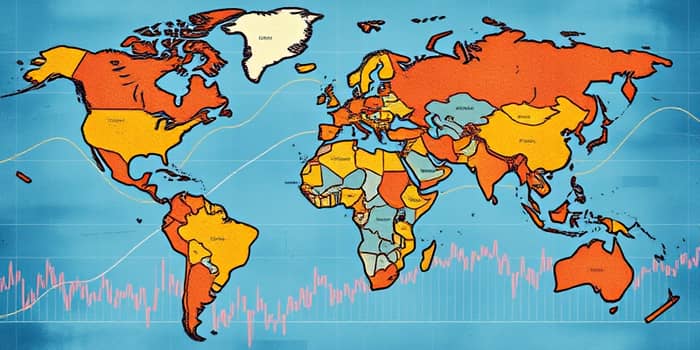In an era defined by shifting alliances, economic nationalism, and emerging conflicts, investors find themselves navigating treacherous waters. Geopolitical developments can sweep through markets like a storm, creating both hazards and hidden opportunities.
Understanding the interplay between world events and portfolio performance is no longer optional. It is a decisive factor in preserving capital and unlocking growth, especially as volatility becomes the new normal.
Why Geopolitics Matters for Portfolios
Today, geopolitical risk has become the leading concern for investors and family offices. Recent surveys show that 84% of family offices view the global landscape as a critical factor molding allocation choices.
Beyond headline shocks, sustained shifts in supply chains, energy flows, and trade barriers reshape long-term risk-reward calculations. Even modest policy tweaks—tariff changes or new sanctions—can ripple across asset valuations.
Major Current Geopolitical Risks and Their Market Impact
Several hotspots define the investment landscape in 2025:
- Ongoing conflicts in Ukraine and the Middle East: Intermittent escalations create sporadic market swings and raise energy price volatility.
- Rising nationalism and protectionism: New U.S. tariffs and retaliatory measures disrupt global supply chains, forcing rapid portfolio rebalances.
- Expanding sanctions regimes: U.S. and EU measures constrain capital flows to sensitive sectors and adversarial jurisdictions.
- Currency and capital flight: Investors are shifting away from dollar assets, driving safe‐haven repricing and forex turbulence.
- Cyber threats and terrorism: Emerging cyberattacks and infrastructure risks are boosting defense budgets and fueling interest in security-focused themes.
Quantitative Trends & Key Numbers
Data underscores how pervasive these forces have become:
These numbers reveal both resilience and fragility. Even as inflation cools, the specter of renewed conflict or policy shifts can reignite price pressures or stall growth forecasts.
Case Studies and Market Responses
April 2025 saw emergency U.S. tariffs trigger a sharp equity selloff, only to rebound within days when measures were paused. This episode demonstrated how swiftly sentiment can swing based on policy signals.
Similarly, tensions in the Middle East—while not yet halting oil supply—keep energy markets on edge. Investor confidence hinges on fleeting ceasefire updates and geopolitical whispers, underscoring the sensitivity of markets to headlines.
Historical parallels from Brexit and the U.S.-China tariff wars show that portfolios often need to be reallocated, with capital flowing out of affected regions into perceived havens or insulated sectors.
Investor Strategies and Responses
Faced with this landscape, portfolio managers are adopting multifaceted approaches:
- Enhanced diversification: 64% of family offices plan to broaden exposure across geographies and asset classes.
- Dynamic risk management: Frequent scenario planning, independent risk reviews, and agile policy updates are becoming standard.
- Shift to defensive themes: National security, critical infrastructure, and cybersecurity are drawing fresh capital.
- Avoidance of high-risk sectors: Investors steer clear of segments vulnerable to sanctions or supply-chain disruption.
By blending short-term tactical moves with long-term thematic allocations, they aim to turn volatility into strategic opportunity, rather than merely reacting to it.
Thematic Opportunities and Risks
Amid uncertainty, select themes stand out:
- Defense and dual-use technology: Rising government budgets fuel innovation in cybersecurity and aerospace.
- Energy security and decarbonization: Shifts toward energy independence and clean tech offer resilient growth pathways.
- Emerging market niches: Certain regions remain relatively insulated from major geopolitical friction.
However, overconcentration carries its own dangers. Investors must balance conviction with vigilance, ensuring no theme becomes a single point of failure.
Forward-Looking Guidance and Conclusion
As we progress deeper into 2025, economic nationalism and geopolitical volatility will remain key drivers of market behavior. Major policy announcements—from Washington, Brussels, Beijing, or Riyadh—can prompt swift reallocations.
Success in this environment rests on a foundation of geographic diversity and dynamic risk review. By integrating geopolitical intelligence into every stage of portfolio construction, investors can position themselves not only to withstand shocks but also to seize emerging opportunities.
Ultimately, geopolitics and finance are intertwined threads in the tapestry of global progress. Embracing the tension between risk and reward empowers investors to chart a more resilient, purpose-driven course through an ever-evolving world.
References
- https://www.vaneck.com/asia/en/news-and-insights/blogs/model-portfolios/how-to-protect-portfolio-from-geopolitical-shocks/
- https://www.ocorian.com/knowledge-hub/insights/critical-importance-geopolitical-issues-family-offices-2025
- https://www.wellington.com/en-us/institutional/insights/geopolitics-in-2025
- https://www.columbiathreadneedle.com/en/gb/intermediary/insights/2025-macro-outlook-slower-growth-amid-geopolitical-uncertainty-but-opportunities-remain/
- https://www.blackrock.com/corporate/insights/blackrock-investment-institute/interactive-charts/geopolitical-risk-dashboard
- https://bradfordtaxinstitute.com/market-outlook/%5BInvestment-Strategy%5D-Portfolio-Diversification-Strategies:-Risk-and-Reward-Today










